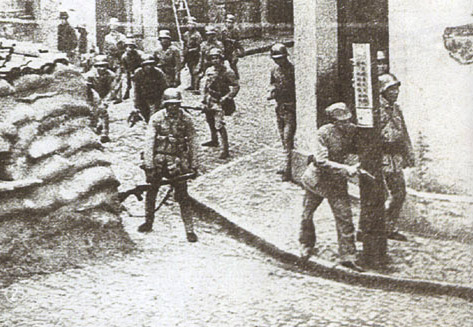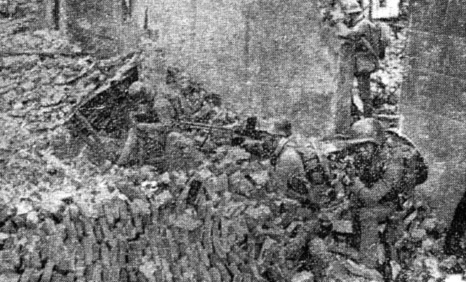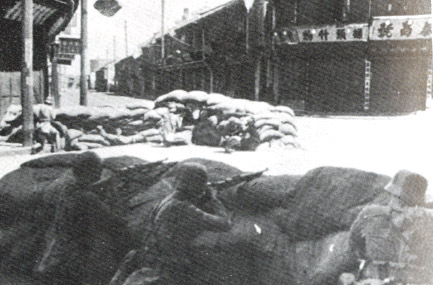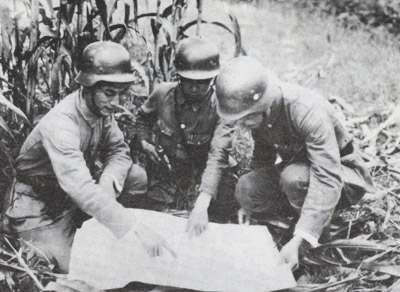Kampfwagen
Junior Member
That must have been somewhat akward for the Germans...though I guess it would not have been the last time.
mindreader said:The KMT had German weapons in name only, unless you happen to be referring to a handful of submachine guns. A German division had more firepower than the entire combined Chinese Army, KMT or CCP.
adeptitus said:It's true that a WW2 German Division was better armed and had more firepower than their KMT/CCP counterparts, BUT, I'd also point out that the German-trained ROC army divisions were organized in 1933-1936 under Hans von Seeckt, and their quality was comparable to German divisions prior to their destruction in 1937 (Battle of Shanghai).
If we look at the quality of the German army in 1936, when they invaded the French puppet state of Rhenish Republic (Rhineland), the Wehrmacht went in on bicycles with Kar 98k rifles on their backs. This was not the same German army that rolled into France in 1940.
The German-trained divisions in China in 1936 was equipped with the same M35 Stahlhelm, with Kar 98k rifles, C96 Mauser pistols, Maxim & MG 35 machineguns, artillery, howitzers, mortars, etc.
The main German tank in 1936 was the Panzer I w/20mm gun. The same tank was supplied to Spain and China, though in limited quanities. The ROC Army only received 15 Panzer I's and a number of Panzerspahwagen 222 armored cars, before the Japanese pressured Germany to end arms delivery to China.
Had the Marco Polo bridge incident not escalated into war, and Von Skeet's 60-division plan complete by 1940, I think the Sino-Japanese war would've turned out very differently. From the Japanese military's point of view, you could say that they had little choice but to gamble on an attack while it was still in their advantage.
mindreader said:Sorry to tell you but, you are a little misinformed. When the Germans and KMT boast how they will train and equip China with 20 divisions, how many do you think actually reached the Chinese? Obviously they failed in such an ambitious, if not impossible goal.
mindreader said:If you want to claim that KMT's Germans trained troops are on an equal footing with the Germans, I'm not gonna argue on that. Not because I think it's true, but merely because there is no basis for comparison. They've never faced each other so it's pointless to argue one way or another.
On the other hand, in terms of equipment, it's not even close. Just look up how many pieces of artillery a German division headquarter has. That, like I said, is more firepower than the entire KMT army. And there is no point even bringing up tanks, planes, ships. Put simply, the KMT had none (worth mentioning).
mindreader said:I don't really want to argue about Chiang's other qualities, but he was a moron. China would have been much better off had he chose to fight in 1931 (instead of letting the Japanese take the Northeast without a fight), back when China and Japan's comprehensive strength was much much closer.
adeptitus said:Most sources cite 8 divisions were complete in the re-org and training, 7 combat + 1 training division. A further 12-20 were "in progress". The original plan was not complete because of Japanese pressure to withdraw German advisors.
Had the Marco Polo bridge incident been resolved peacefully, it's not impossible to think 20 ROC Army divisions could've completed their re-org and training by 1940. Heavy equipment, however, is another story.
If we're talking about German Infantry divisions (not Panzer divisions or Panzer armies), each German division had its own artillery brigade armed with some 105mm and 150mm artillery, plus heavy mortars. Except for elite units or Panzer armies, most German infantry divisions were not mechnized and was powered on 2 legs or 4 legs (4,000 - 5,000 horses/division), plus some bicycles, motorcycles, and trucks they can get their hands on.
The German-trained divisions in China were comparable in light arms up to light machineguns, but was only equipped with half as many heavy machineguns, mortars, and far fewer artillery. As an infantry division, they were prolly comparable to the German infantry that invaded Rhineland in 1936, but definately not the German army that rolled into Poland a few years later.
On artillery comparison, in 1933 the ROC Army had 134 Infantry divisions and 9 Calvery Divisions, but only 5 artillery brigades and 20 artillery regiments. Obviously there wasn't enough artillery go around, but if you combine the ENTIRE ROC Army's artillery guns in 1936, it's numerically superior with more firepower than a SINGLE German infantry division's artillery regiment.
If we move up the timeline a little, after the Germans withdrew their support, the ROC went to Soviets for help, and the Soviets delivered over 1,300 artillery pieces and 1.9 million shells between 1937-1939. I'm pretty sure that's more than what a single German division has in artillery.
Perhaps, but by the Marco Polo bridge incident it was too late to go back and change history. Chang should've listened to Alexander von Falkenhausen.
mindreader said:Like I said, you are simplifying the situation. Even if we suppose outright war did not occur in 1937, no amount of supplies would have reached the Chinese any ways. The Japanese were already effectively blockading China's eastern seaboard.
I also don't know why you insist on leaving out heavy equipment. Like I said, if you are referring to the submachine guns and some LMG, yes the Chinese had limited access to those. But surely you aren't suggesting that they try to streamroll Japanese tanks on China's central plains with those.
mindreader said:Also, you are a little late. The Soviets have been providing aid to China before the Germans. They have done so since the mid 20's, though primarily financial aid. Since we are discussing alternative history here, there is a far greater chance that the Soviets, Americans and British provide China with aids earlier had the war occurred earlier than there is chance that the Germans would equip China with 20 divisions, in which we know they failed to do.
adeptitus said:...and here enter the realm of "what if" questions...
If we were to assume that the Marco Polo bridge incident had been resolved peacefully:
1) Would German military assistance have been withdrawn in 1937?
2) Would Japan still blocade all Chinese seaports from East to South?
3) Would additional deliveries of German-made heavy weapons, such as 150mm artillery, been made to China in exchange for tungsten up to 1940?
4) Would the Chinese munitions factories at Hanyang, Guangdong, and Taiyuan have been able to produce heavy weapons (37mm anti-tank guns?) from German-supplied blueprints by 1940, like it did with machineguns in 1930s? Would the Chinese-produced heavy weapons (if any) be effective vs Japanese tanks such as the Type 89 & Type 95?
The Chinese munitions factories were known to produce simple stokes-type mortars in 1930s, but not heavy artillery. The NRA was stuck mostly with WWI-era 75mm field and mountain guns. Too bad the development of recoilless rifles and Panzerfaust came so late, had they been adopted earlier, and perhaps imported to China and produced locally, it'd have made a big impact against the lightly-armored Japanese tanks.
IMO from geographic point of view, it's a lot easier for Sovies to send aid than the Germans. The Soviets can simply ship them over the border by land, vs. Germans have to send it by ship.
Chiang could've retained Soviet aid, had he not expelled them in 1926. But that's another historical "what ifs". Since it was already done, he had to look for someone else to provide aid, and Germany was happy to oblige.

























